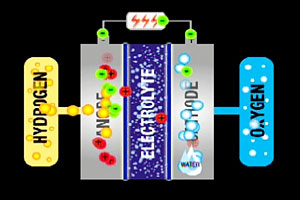
From November 20 thru December 1st, the Tokyo Motor Show went off without any backfire and showcased a display of all types of vehicles. Everything from the cube-like DECA DECA super space vehicle to the quirky convertible X-Lander was displayed with vigor and intrigue. One notable display at the 2013 show was the Toyota FCV Concept Car. This car is powered by a hydrogen fuel cell.
The Elusive Hydrogen Fuel Cell
The idea behind the hydrogen fuel cell is simple. When hydrogen and oxygen combine they create H2O, heat, light, and a loose electron. This loose electron is captured and used as a power source.

How Did Groves Battery Work?
Sir William Robert Grove is considered to be the father of the fuel cell. In 1839 he created a “gas voltaic battery.”
He based his experiment on the fact that sending an electric current through water splits the water into its component parts of hydrogen and oxygen. So, Grove tried reversing the reaction – combining hydrogen and oxygen to produce electricity and water. This is the basis of a simple fuel cell.
The idea of reverse engineering got other scientists thinking. How did he figure that out? Though it is a simple concept, the use of hydrogen fuel cells has long been naught but an alchemist’s dream. Scientists have spent the last 150 years negotiating the delicate balance of cost efficiency. With the yield being far less than the cost of production, the experiments performed by Charles R. Alder Wright and C. Thompson led them to this conclusion:
our results were sufficiently good to convince us that if the expense of construction were no object, so that large coated plates could be employed, enabling currents of moderate magnitude to be obtained with but small current density, there would be no particular difficulty in constructing [cells] of this kind, competent to yield currents comparable with those derived from ordinary small laboratory batteries; although we concluded that the economical production of powerful currents for commercial purposes by the direct oxidation of combustible gasses did not seem to be a problem likely to be readily solved, chiefly on account of the large appliances that would be requisite
Or… “we don’t have enough money and resources.”
Related Article: Technological Advancements: A Detriment to Our HearingNASA’s Use of Fuel Cells In Space
NASA has been using fuel cell technology since the Gemini missions, which was a stepping stone to the Apollo missions. The Gemini missions gave NASA the opportunity to test, develop, and refine their space faring abilities.
Since then NASA has continued to pursue three different types of fuel cell technology: Proton-exchange-membrane fuel cells (PEMFCs), regenerative fuel cells (RFCs), and solid-oxide fuel cells (SOFCs).
PEMFCs: In theory these cells should last the longest out of the three. The only emissive byproduct of this cell is water. This water is said to be so pure that NASA plans to use it as drinking water for astronauts.  While the future of these cells is bright they are definitely in need of further refinement.
While the future of these cells is bright they are definitely in need of further refinement.
RFCs: What a wonder that such a thing exists. These fuel cells create electricity, water, and heat. After the process the water is then introduced to a solar-powered electrolyzer. This takes the water and turns it back into its basic components: hydrogen and oxygen.
SOFCs: These cells are the most efficient of the three. They take energy from directly oxidizing fuels. The type of fuel is flexible and the cell is a long term champion. The only downside is that these cells need to operate at temperatures between 600-1000°C (1112-1832°F). Which… is something to sweat about.
From the Stars to the Garage
NASA has been quite generous in helping to provide the technological state we live in, from awarding the grant to the inventor of the mouse (the one you’re likely using right now) to aiding in the aerodynamic creation of the Nerf Glider. With the fuel cell it isn’t any different. Heck, they’re currently working with the Cleveland RTA using a hydrogen fuel cell powered bus to transport commuters to and fro.
The technology has even left the research labs of NASA and made its way into other industries. As I mentioned earlier, cars too are now being conceptualized with Zero emissions. Well, there’s water of course.
2013 has shown us Toyota’s first attempt at the hydrogen fuel cell car. This new year already has its promises! In California, Hyundai plans to introduce a “free fuel” program that will start with 1000 cars and only a few dealerships. American car companies are also planning to release their own fuel cell powered vehicles but you may have to wait a little bit longer. By 2017 Ford intends to introduce its own Hydrogen Car.
It seems that 150 years of experimentation is starting to bear fruit- Not the kind that laypeople have to watch distantly orbiting our planet. Rather, we will begin to see a transformation of our society away from haste and waste and move toward longevity and thoughtfulness.
Related Article: Waking Up: New State of Consciousness ProposedSources:
http://www.qrg.northwestern.edu/projects/vss/docs/power/1-what-are-fuel-cells.html
http://en.wikipedia.org/wiki/Hydrogen_vehicle
http://en.wikipedia.org/wiki/Fuel_cell_vehicle
http://americanhistory.si.edu/fuelcells/origins/origins.htm
http://paultan.org/2013/11/21/tokyo-2013-daihatsu-deca-deca/
http://www.topspeed.com/cars/suzuki/2013-suzuki-x-lander-ar160981.html
http://www.corrosion-doctors.org/Biographies/GroveBio.htm
http://www.nasa.gov/mission_pages/gemini/index.html
http://www.nasa.gov/centers/glenn/technology/fuel_cells.html
http://www.siei.org/electrolyzers.html
http://www.nasa.gov/vision/earth/technologies/spinoffs.html
http://www.technologyreview.com/view/510416/ford-daimler-and-nissan-commit-to-fuel-cells/



